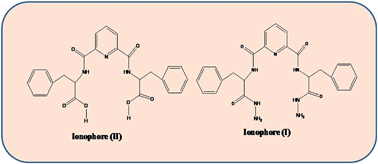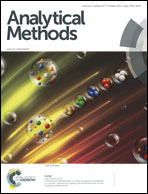Fabrication of novel sensors based on a synthesized acyclic pyridine derivative ionophore for potentiometric monitoring of copper
Abstract
Two synthesized acyclic di-peptide pyridine derivatives were used as an effective neutral ionophore, and potassium p,chloro tetraphenylborate (KpClTPB) as anionic excluder for copper-selective poly(vinyl) chloride (PVC) membrane sensors. The sensors exhibited fast and stable near-Nernstian response over a concentration range of 8.0 × 10−6 mol L−1 to 1.0 × 10−2 mol L−1 Cu2+ with a cationic slope of 26.2–23.3 mV per decade at a pH range 3.5–5.5 with a lower detection limit of 0.32–0.57 μg mL−1. Effects of plasticizers, lipophilic salts and various foreign common ions were also tested. The validation of the method revealed good performance characteristics, including long life span, good selectivity for Cu2+ over a wide variety of other alkalis, alkali earth and transition metal ions (e.g. Na+, K+, Ag+, Hg2+, Ca2+, Zn2+, Cd2+, Co2+, Pb2+, Ni2+, Fe2+, Mg2+, Fe3+), long term stability, high reproducibility, fast response, low detection limit, wide measurement range, acceptable accuracy and precision. The sensors were successfully applied to direct determination of copper(II) in water and waste water samples. The results agreed fairly well with data obtained using atomic absorption spectrometry.


 Please wait while we load your content...
Please wait while we load your content...